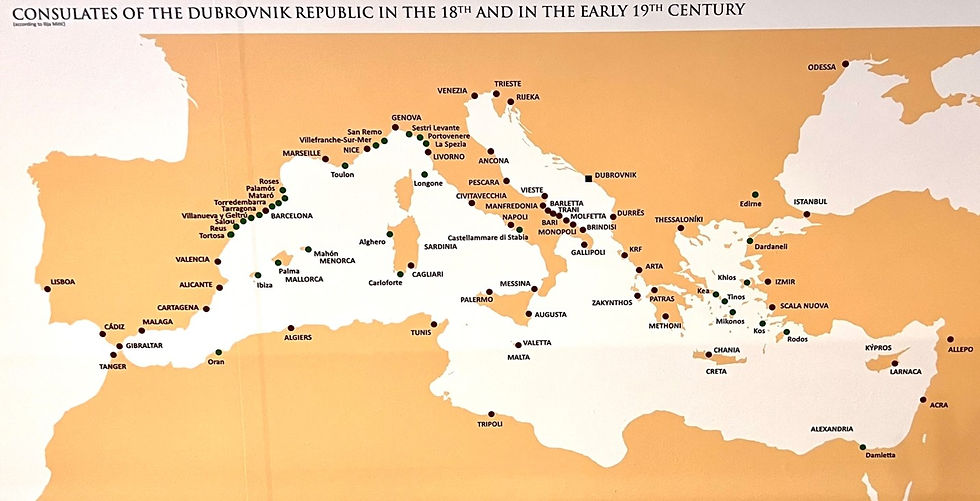How Konavle’s History and Culture Contributed to the Economy of California
- nikolaradonich
- Jun 12
- 4 min read
Updated: Jun 13
Donna F. Mekis and Kathryn Mekis Miller
Authors of Blossoms Into Gold: The Croatians in the Pajaro Valley
We spent six years conducting research on the history of the Croatians in the Pajaro Valley for our book, Blossoms Into Gold: The Croatians in the Pajaro Valley. Throughout those years
several important themes emerged, and we would like to share them with you.
When people migrate from one country to another, their unique traditions, perspectives, and
ways of life accompany them. The majority of Croatian immigrants who settled in Watsonville
and the surrounding Pajaro Valley of California were from the region of Konavle, part of the
former Dubrovnik Republic. This Republic had prioritized and excelled at organized government, diplomacy, and international shipping and trade. We believe the immigrants from Konavle brought their traditions and cultural knowledge with them to California. They took trade beyond local borders for granted, and from an early age recognized potential opportunities when they saw them. Their grandfathers and great-grandfathers had honed these same perspectives throughout centuries of dealings as part of the highly successful Dubrovnik Republic, and they passed their knowledge and outlook to their children and grandchildren through their extensive history of oral tradition.

In addition, immigrants from Konavle had grown up in traditional zajednice (family compounds). A Zajednica consisted of a large family home and property where up to forty members of an extended family lived, farmed and traded. They all worked together within a highly organized family unit, where decisions were made by the leader of the family (domaćin) based on organization and productivity, rather than the desires of individuals. The order and timing of each family member’s daily chores were determined for the efficient internal workings of the household, as well as for the zajednica’s production and trade with the community and the outside world. Zajednice were essential to the survival of Konavle families both socially and economically with the goals of production and profit.
The field of cultural anthropology acknowledges that immigrants bring their diverse
cultural traditions to their new societies, enriching the cultural landscape and contributing to fresh ways of seeing and accomplishing their goals. The earliest arrivals from Konavle were willing and capable of visualizing a new agricultural economic chain similar to what they had seen at home. Developing and participating at every level of this economic chain had been taken for granted. When these young men landed in California in the last decades of the 19th century they were able to define the steps of farm labor, organize efficient transportation systems, administer community banking, and later develop new forms of marketing. Most importantly, however, they recognized fresh produce as a commodity that could be shipped long distances and internationally at a time when other Californians had not considered this a possibility.

The organizational structure visualized by the men from Konavle made it possible for them to develop and sustain Watsonville’s highly productive apple industry and build peripheral support businesses for close to one hundred years.
There were many factors that came together to make what the people from Konavle achieved in the Pajaro Valley possible: their understanding that long-distance trade was feasible, their cultural understanding of working in structured organizational groups, the availability of land, the arrival of the railroad, the shortage of labor in the Pajaro Valley, apple blight in the nearby Santa Clara Valley, and the rapidly expanding population of San Francisco.
The success of these Croatians was celebrated in Jack London’s 1913 novel, Valley of the Moon. In the novel, a farmer named Benson is talking to a young couple he’s picked up on his way to Watsonville:
“Wait till we strike the Pajaro Valley…I’ll show you what can be done with the soil…Do you know what they call the Pajaro Valley now? New Dalmatia…We Yankees thought we were smart. Well, the Dalmatians came along and showed they were smarter…First, they worked at day labor in the fruit harvest. Next they began, in a small way, buying the apples on the trees. The more money they made the bigger became their deals. Pretty soon they were renting the orchards on long leases. And now they are beginning to buy the land. It won’t be long before they own the whole valley…Why, those Dalmatians are showing Pajaro apples on the South African market right now…”

It is our belief that these Croatians saw an opportunity and were successful at implementing it because they understood the possibilities of long-distance shipping; of working together in structured groups (which they emulated in building Watsonville’s apple industry); and in organizing all levels of the fruit production business—from farm-laborers to packing house workers to bank board members. Croatian immigrants from Konavle successfully developed the first model for shipping fresh produce from California throughout the United States and internationally. All western states quickly adopted this methodology, a model that is still in place today.
Srednja Europa, d.o.o. will be publishing Blossoms Into Gold: The Croatians in the Pajaro Valley in the Croatian language in 2026.




